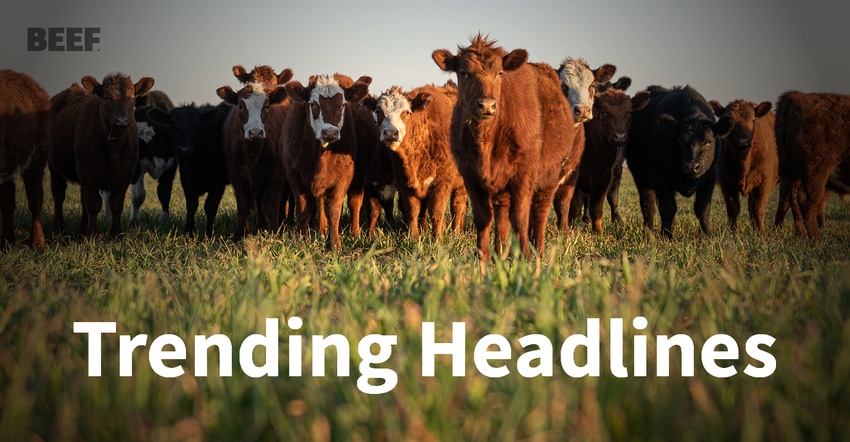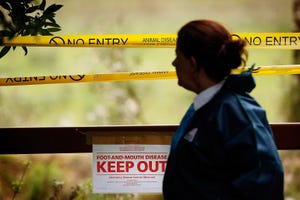5 Trending headlines in the beef world - Apr 12, 2022
Check out what everyone is talking about in the beef world.

There is a lot going on in the Beef world and we are trying to give you a snippet of what’s happening outside your door this week.
Did someone forget it’s spring? That’s probably on the minds of the many cattle producers as they prepare their ranches in the norther Plains and surrounding areas for a blizzard that could leave 20 foot snowdrifts behind.
AccuWeather forecasters are warning that a "storm of the century" could unfold across parts of the northern Plains this week and challenge snowfall records last set during cattle-killing blizzards.
The storm is expected to move eastward from the Rockies before crossing over into Canada, but not before catching a few ranches during the calving season.
Over the last few days, Katelyn Dynneson-Larson has been preparing her livestock at Dynneson Ranch in Sidney, Montana, near the western border of North Dakota. While her Gelbvieh cross cows are suited for the chilly weather, the newborn calves will take much more work to keep warm and safe.
"The main issue is that we have been really warm lately, so it will be a shock to everyone," Dynneson-Larson told AccuWeather.
Richland County, where the Dynneson Ranch is located, is experiencing extreme drought conditions, according to the U.S. Drought Monitor.
So while the storm will bring snow and impact her calves, Dynneson-Larson said she's looking forward to an end to the dry spell.
"The mud and moisture will be a welcome respite from the dust we’ve been experiencing for the past two years," she said. "We really need this moisture to help get our grass off to a start so the cows can graze this summer."
To prepare for the snowstorm that's standing between the ranch and greener fields, Dynneson-Larson and her family have been moving the cows into pastures and pens with windbreak and shelter to shield them from the elements and laying down straw for them to bed. She said they've also been stockpiling feed and bedding close by to have on hand.
Currently, the ranch has roughly 300 calves on the ground more than midway through the calving season. But even with all the preparation, taking care of these calves during the storm will be an all-hands-on-deck job.
Early-spring storms often come with a fair amount of damage since the snow is usually wet and heavy, and the potential loss of power could efforts to keep everything running smoothly.
And if 2022 hasn’t stressed cattle ranchers out enough, another issue has peaked. 2021 was packed with drought and it’s impact isn’t over.
In the Baker City Herald, it’s reported that some public rangelands were so damaged in the West's 2020-2021 wildfires that they can't yet be grazed again at full capacity.
"People are scrambling for grass, and it's tough — really tough," said Matt McElligott, president-elect and public lands committee chair of the Oregon Cattlemen's Association.
Jack Hanson, California rancher and chairman on the Public Lands Council, said producers with cattle on grasslands owned by the U.S. Bureau of Land Management will have to deal with drought, but they're likely better off than those with U.S. Forest Service allotments that burned.
Dave Daley, California rancher and chairman of National Cattlemen's Beef Association's Federal Lands Committee, is among those still suffering from 2020's fires.
September of 2020, the Bear Fire tore through the Plumas National Forest, scorching Daley's range. Partly because of thick forest fuels, the fire burned intensely.
"This is not a two-to-three-year recovery," he said. "This could be generational, long-term damage."
Daley's cattle could not graze the area in 2021, and he said the range still "doesn't look good."
This spring, Daley and Forest Service range conservationists will determine how many head of cattle can graze based on forage and ecosystem recovery. Daley has reduced his herd from 800 to 500 head and may sell more cattle.
Daley said he's frustrated with how slow-moving the federal government is at restoring burned land. A year and a half after the fire, the Plumas National Forest is still littered with trees.
"All that dead timber could become fuel for fire again," said Daley. "(The Forest Service's) ability to move quickly in a catastrophic situation doesn't exist. I don't blame the individuals in the Forest Service, but the bureaucracy is so huge."
In southeast Washington's Blue Mountains, cattle rancher Sam Ledgerwood faces similar challenges after the Lick Creek Fire burned his Forest Service allotment in 2021, halving the number of cattle that can graze there.
Some of the beef cattle in a no-antibiotics program tested positive for antibiotics, which could call into question the “raised without antibiotics” label on products, according to a new study in Science.
Most cattle in the study — about 85% — tested negative for antibiotics. However, 10% came from lots where at least one cow tested positive, and another 5% came from lots with multiple positive tests.
“These findings provide empirical evidence that a material portion of beef products currently being marketed with [raised without antibiotics] labels is from cattle that were treated with antibiotics,” the study authors wrote.
Researchers at George Washington University’s Antibiotic Resistance Action Center and Food In-Depth, a food-testing company, tested the urine of nearly 700 cows at one slaughterhouse that processes “raised without antibiotics” cattle. All of the cattle were part of a “no antibiotics ever” program, with a subset produced under the Global Animal Partnership program, an animal welfare rating program pioneered and used by Whole Foods.
By using a rapid test that screens for 17 antibiotics commonly administered in feed and water, the research team sampled animals from every lot of cattle delivered for processing at the slaughter facility over seven months. They tested animals from 312 lots and 33 different feedyards, representing about 38,000 cattle or 12% of U.S. raised-without-antibiotics beef production during the study period.
The researchers found that three feedyards had multiple lots in which all samples tested positive for antibiotics, and four feedyards had all samples test positive in a single lot. In addition, seven feedyards had a positive sample in more than one lot, and 14 had at least one animal test positive.
Overall, lots with at least one positive test represented about 15% of the raised-without-antibiotics cattle processed at the slaughter facility during the seven months. About 26% of cattle slated for the Global Animal Partnership program came from a lot with at least one positive test.
“These findings suggest that today’s RWA labels lack integrity,” the study authors wrote. “Although our testing was limited to beef cattle, other meat and poultry sectors are vulnerable to similar incentives.”
The U.S. Department of Agriculture is charged with monitoring antibiotic use and verifying label claims such as “raised without antibiotics,” according to The Washington Post. A USDA spokesman told the newspaper that the agency looks forward to reviewing the study more closely to determine the next steps but said that “there is no indication within the study that the meat tested is unsafe to consume.”
Inflation will be a top headline for 2022. It’s the culprit behind grocery store prices. According to the Labor Department, the Consumer Price Index jumped 8.5% from March 2021 to March 2022, the largest year-over-year increase since December 1981.
Monte Rouquette, forage physiologist, and Gerald Smith, clover breeder, both in the Texas A&M College of Agriculture and Life Sciences Department of Soil and Crop Sciences, said the rules for managing pastures and livestock systems are changing with increasing fertilizer and fuel costs.
“The energy crisis experienced in years past was just an appetizer compared to what cattle operators are experiencing now in forage-animal production,” Rouquette said. “They have experienced increased prices in fuel, fertilizers and feed ingredients, and now the costs of ‘doing business’ have caused many to rethink their operating strategies.”
Setting production targets, managing to manipulate forage utilization systems to enhance economic returns, and sustaining the soil-plant resources are still the name of the game, he said. But the process may be different under high input prices.
Stocking strategies and nutrient cycling have inseparable relationships, Rouquette said. There is an increased dependency on recycled nutrients in grazed pastures for forage production during unstable and increasing fertilizer, fuel and feed grain costs.
About the Author(s)
You May Also Like


.png?width=300&auto=webp&quality=80&disable=upscale)
